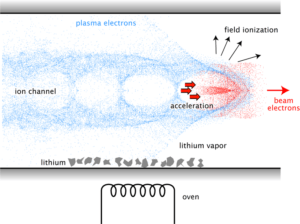
Supercomputing is the silent power behind many recent innovations. Like, when we hear about the discovery of a new drug or method to cure Cancer using personalized immunotherapy. Mapping of the human genome has provided the insight and lead to various possibilities of exploring the potential gene mutations possible for a person based on his DNA and thus personalize medicine and treatment. Or, the discovery of superlight materials for engineering applications like satellites and spacecraft. We could possibly think of building space elevators too! Or if we could have a material that could exhibit superconductivity then signal transfers without loss could be a reality and change the way we communicate! In reality discovery of such materials can be very tedious and practically not possible in the span of a person’s lifetime without these supercomputers. Simulation of cluster formation of galaxies possible with the help of a supercomputer. We achieved a lot of technology in IT industries. Not only things were discovered but also they were evolved like LCD TV evolved from old televisions, motorcycles were evolved from cycles, in the same way, supercomputers were also evolved from computers. What is a Super Computer? First, you might think that they have superpowers. Absolutely not! But they are most superior to any ordinary computer.
Supercomputer might be 20 times faster and bigger than any ordinary computer. Supercomputers are primarily used for complex scientific and mathematical calculations. The parts of a supercomputer are similar to a desktop computer: they both contain hard drives, memory, and processors. Most current desktop computers are actually much faster than the first supercomputer. Supercomputing is the main power behind many recent innovations and research. The first supercomputer was the Cray-1. developed by Cray Research in the 1970s. The Cray-1 was capable of computing by using a form of supercomputing. The supercomputing process is called vector processing. It consists of the rapid execution of instructions in a pipelined fashion. An ultimately faster method of supercomputing was introduced in the 1980s, which is known as parallel processing. Parallel processing applications are able to solve computational problems by simultaneously using multiple processors.
Supercomputers are very powerful and they can provide researchers and scientists with insight into phenomena that are too small or too big to observe in laboratories. Supercomputers work is that how molecules interact with each other. With the help of Supercomputing simulations, scientists easily study molecules and their interaction. With the help of a supercomputer, Researchers can determine the shape of a molecule and its geometry. Modern supercomputing applications involve the advancement of artificial intelligence. Use of supercomputers enables scientists to improve the understanding of the structure and functioning of the brain. Sunway Taihu Light is the fastest supercomputer in the world.
INDIA’S SUPERCOMPUTERS
India has 11 of the top 500 supercomputers in the world. SahasraT (Cray XC40) and Centre for Development of Advanced Computing PARAM Yuva – II are one of them. SahasraT supercomputer is located at Supercomputer Education and Research Centre (SERC) facility at IISC Bangalore. Supercomputer Education and Research Centre is India’s state-of-the-art research facility for high-performance computing in the field of science and engineering. It has a 96th position in the Top500 list of top 500 supercomputers in the world. Param Yuva II was made by Centre for Development of Advanced Computing in a period of three months. It performs at a peak of 524 teraflops and consumes 35% less energy as compared to Param Yuva. It is the first Indian supercomputer achieving more than 500 teraflops. Param Yuva II will be used for research in space, bioinformatics, weather forecasting, seismic data analysis, aeronautical engineering, scientific data processing and pharmaceutical development. Educational institutes like the Indian Institutes of Technology and National Institutes of Technology can be linked to the computer through the national knowledge network. This computer is a stepping stone towards building the future petaflop-range supercomputers in India.
Written by: Akshat Lal, Class: 12th Saint Joseph Academy



